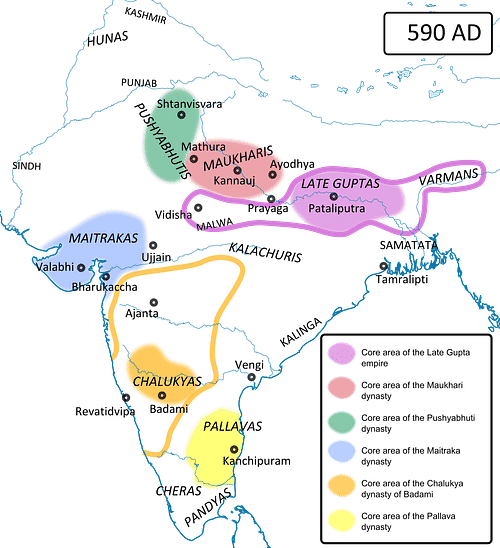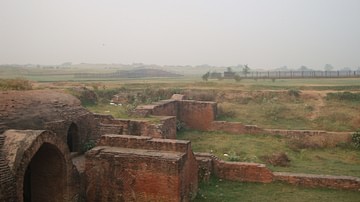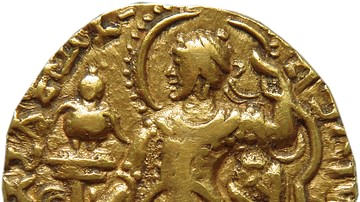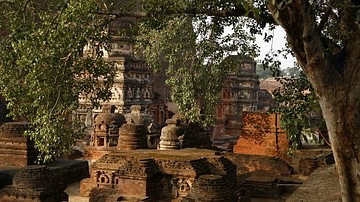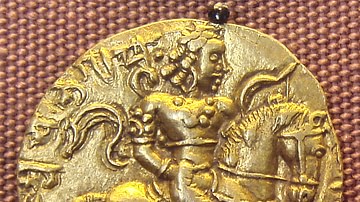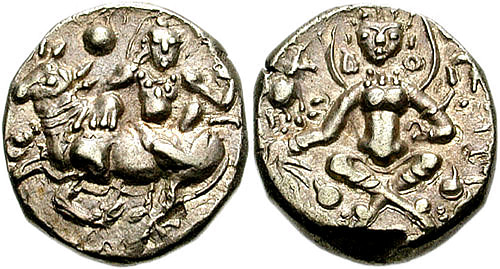
The Gauda Kingdom came into being in the late 6th century CE in eastern India, as a result of the political disintegration of the Gupta Empire (3rd-6th century CE). Its core areas were situated in what is now the state of Bengal in India and the northern parts of the country of Bangladesh, with the capital at Karnasuvarna (near modern-day Murshidabad city). For a brief period, under King Shashanka (c. late 6th century CE - 637 CE), it became a powerful kingdom vying with other regional powers for political supremacy in India. But its rise was soon accompanied by its fall, and it passed into history as the base kingdom for future empires, most notably under the Palas (8th-12th century CE).
Prelude: the Gupta Empire in Bengal
The Gupta emperor Samudragupta (335/350 – 370/380 CE) made vast conquests to such an extent that he came to be called as the “Indian Napoleon” by historians. He gained suzerainty over many parts of India. Samudragupta's conquests included Bengal, and only the kingdom of Samatata in eastern Bengal was spared as it became a tributary state "acknowledging the suzerainty of the Gupta Emperor, but with full autonomy in respect of internal administration" (Majumdar, 47). However, over time it became gradually incorporated into the Gupta Empire.
According to epigraphic records, northern Bengal under the reign of Emperor Kumaragupta I (414-455 CE) formed an important administrative division of the Gupta Empire, Pundravardhana-bhukti (bhukti implying province). A governor appointed by the emperor himself was in charge, who in turn, appointed officers to various districts. Occasionally, even the district officers were appointed directly by the emperor.
Fall of the Guptas & Rise of the Gauda Kingdom
Northern Bengal continued to form an integral part of the Gupta Empire until the end of the 5th century CE. The fall of the Gupta Empire and the absence of any other empire in its stead led to the political disintegration of northern India and the rise of a number of independent powers:
- the Pushyabhutis (also called as the Vardhana dynasty by some historians) of Sthanvishvara (Thanesvara or Thanesar, in present-day Haryana state)
- the Maukharis of Kosala/Kanyakubja (present-day state of Uttar Pradesh)
- the Later Guptas of Magadha and Malwa (present-day states of Bihar and Madhya Pradesh).
In Bengal, two powerful independent kingdoms of Vanga and Gauda were created in the 6th century CE. The Gauda Kingdom comprised of the northern and most of the western parts of Bengal. Here, the imperial Gupta hold was stronger than in Vanga and so the Later Guptas continued to maintain their pre-eminence until the end of the 6th century CE. The Gaudas under the Later Gupta kings were at war with the Maukharis, a struggle which began in mid-6th century CE in order to conquer Magadha (modern-day Bihar). Maukhari inscriptions of mid-6th century CE refer to the "warlike activities of the 'Gaudas living on the seashore'" (Tripathi, 354) and their defeat at the hands of the Maukharis, as a consequence of which they were further driven towards the sea coast. The Aryamanjushrimulakalpa, a Buddhist text written sometime after the 6th century CE, contains a chapter on the history of India and of Gauda and Magadha in particular.
King Shashanka
In the 7th century CE Gauda became independent of Later Gupta rule. The only ruler known for the Gauda kingdom was Shashanka or Shashankadeva. Information about King Shashanka has been made available by his coins, inscriptions, and the Harshacharita, the biography of the Pushyabhuti emperor Harshavardhana or Harsha (606-647 CE), written by his court poet Banabhatta or Bana (c. 7th century CE).
Regarding Shashanka's "early life and the circumstances under which he came to occupy the throne of Gauda we possess no definite information" (Majumdar, 59). The inscription on the seal found at Rohtas fort (present-day Rohtas, Bihar state) shows that Shashanka was ruling there as a mahasamanta (high-ranking feudatory) “apparently under the Gauda king ruling from Karnasuvarna at the time” (Sircar, 20) who was probably the Later Gupta king Mahasenagupta. Shashanka overthrew him in late 6th century CE and became the first king of independent Gauda. The Later Guptas however continued to rule from Malwa and other remaining areas.
The political conditions of northern and eastern India at time ensured that any ruler of worth had to strengthen his position first. Shashanka realized this and came into alliance with Mahasenagupta's son Devagupta (c. 6th century CE – early 7th century CE), his hostility with his former overlord notwithstanding. The increasing power of the Maukharis, especially after their alliance with the Pushyabhutis, and the threat it presented to the Later Guptas necessitated that Devagupta accept the alliance with Gauda. Together, they marched against Kanyakubja (present-day Kannauj city, Uttar Pradesh state) and attacked and killed the Maukhari king Grahavarman (c. 6th century CE – early 7th century CE).
Banabhatta in his Harshacharita mentions the role of Shashanka in causing mayhem in the life of his patron Harsha. Harsha was preceded by his elder brother Rajyavardhana who had come to the throne in 605 CE. Their sister Rajyashri was married to Grahavarman. After killing him, Devagupta occupied Kanyakubja and imprisoned Rajyashri. Rajyavardhana marched with his army to defeat him and rescue his sister. He reached Kanyakubja and defeated the Malwa army en route, possibly killing Devagupta. Shashanka, allied to the Malwa king, came to his aid and “according to the story given in the Harshacharita, Rajyavardhana was killed by Shashanka through a stratagem” (Singh, 562). Bana writes:
[Prince Harsha] learnt that his brother, though he had routed the Malwa army with ridiculous ease, had been allured to confidence by false civilities on the part of the King of Gauda, and then weaponless, confiding, and alone, despatched in his own quarters. (Banabhatta, 209)
Shashanka went on to occupy Kanyakubja. Bana states that unable to accept this act of murder, Harsha lashed out at the character of Shashanka:
'Except the Gauda king', he cried, 'what man would by such a murder, abhorred of all the world, lay such a great soul low…in the very moment when…he had laid the sword aside? ... What shall be his doom? ... Into what hell shall he fall? My tongue seems soiled with a smirch of sin as I take the miscreant's very name upon my lips…By lighting up this evil path this vilest of Gaudas has collected only foul shame.' (Banabhatta, 210-11)
Wondering "what now will be the wretch's fate?" (Banabhatta, 211), Harsha swore vengeance on Shashanka and declared war. He marched with his army and concluded a treaty with King Bhaskaravarman (600-650 CE) of Kamarupa (present-day Assam state). The unfinished Harshacharita is silent on what happened afterwards. "Indeed, the court poet does not even inform us how his patron proceeded against the Gauda king, who was the immediate object of his wrath" (Tripathi, 296). It appears that at that point, Shashanka fearing the combined might of Harsha and Bhaskaravarman and his own weak position, especially after the rout of the allied Malwa army, withdrew from the contest. Harsha managed to rescue his sister and occupy Kanyakubja. Avantivarman, Grahavarman's younger brother, succeeded to the throne and after his death, Harsha became the king of the Maukhari realm.
That Shashanka remained very much a threat to Harsha is demonstrated by the fact that a member of the Later Gupta family was “subsequently placed by Harshavardhana in Magadha as his feudatory or Viceroy, so that he might be a bulwark against the aggressions of Shashanka” (Tripathi, 287). Shashanka continued to rule for a long time (nearly 32 years) after his retreat from Kanyakubja. Eventually, Harsha “defeated Shashanka and extended his control over parts of parts of Kongoda in Orissa” (Singh, 562). However, direct control over all of Gauda territories was only achieved after Shashanka's death in 637 CE.
The Harshacharita is the only historical source that comes close to describing Shashanka as a person. However, it must be noted that Bana, for obvious reasons, had his own biases and hence depicted Shashanka as a villain who had committed a heinous crime deserving a fitting punishment. Many historians thus doubt the authenticity of the account of Bana, stating that Rajyavardhana's death was not the result of foul play and Shashanka, being the great king that he was, could not stoop so low. However, the way war was waged in ancient India and political rivalries dealt with, it was not altogether improbable that such incidents could occur.
Intrigue and slaying of enemies was very much part of the military-political fabric. In ancient India, murders and assassinations of kings by their rivals was not unknown and was even recommended as a standard practice by strategic thinkers including Kautilya (c. 4th century BCE). In his Arthashastra, Kautilya writes that while dealing with a conqueror, a conquered king could after “entering into the palace, slay his enemy while sleeping” (Shamasastry, 561). Shashanka thus may not have found it impudent to kill the enemy king Rajyavardhana who had defeated his friend Devagupta. This could be particularly true at a time when the Malwa army already having lost, the Gauda king was not in a position to militarily take on his opponent.
Shashanka thus appears as a warlike monarch, who concluded treaties and made allies so as to improve his position in the post-Gupta period characterized by political instability. He carried on the continuing war with the Maukharis, and for this, befriended their enemies the Later Guptas. He understood the danger from the rising power of the Pushyabhutis and sought to hold his own against them, particularly when the Pushyabhutis formed their own alliance with his age-old enemies the Maukharis and the Kamarupa king. He came to assist his allies through his army and through the much-prevalent means of intrigue. He continued to hold power even in the face of a determined and powerful adversary like Harsha. He desired land and chose to conquer and occupy territories whenever he could. In all this, he was no different from any other king of his time.
Extent of the Kingdom
The Chinese Buddhist monk-scholar Hiuen Tsang or Xuanzang (602-664 CE) who visited India in the 7th century CE, states in his work Si-yu-ki that Shashanka, or She-sang-kia, was the king of Karnasuvarna, "Karnasuvarna having been the capital of the Gauda kingdom during the age in question" (Sircar, 4).
Shashanka's kingdom incorporated many territories, including Magadha and Ganjam in the present-day state of Odisha. It is not known whether he or his predecessors had added these new lands to their dominion, but it seems more likely that it was Shashanka himself who carried out these conquests; however, "the details of this or other campaigns that Shashanka must have waged in the south are unknown to us" (Majumdar, 60). His inscriptions dated 619/20 CE describe him as Maharajadhiraja (Sanskrit: "Lord of Great Kings") ruling over the earth surrounded by the four oceans, together with islands, mountains, and cities. This title was less in grandeur compared to the imperial Gupta titles but denoted much more power and authority than the simple maharaja (Sanskrit: "Great King") of the Vanga kings.
Government & Religion
In terms of administration, by and large, the Gupta style was maintained. It was easier to continue with a prevailing system with which both the people and officials were familiar than to institute something entirely new, especially when a ruler like Shashanka had to devote a good amount of his energy to maintaining his political position in the face of strong adversaries. The administrative divisions like bhuktis and below were continued along the old lines. As under the Gupta rule, district officers were also appointed sometimes directly by the king who had now replaced the authority of the Gupta emperor. The king issued commands in Gupta style to a large number of officials.
Shashanka actively championed Hinduism, even at the cost of other religions. The coins of Shashanka clealy show his preferences: the Hindu god Shiva is depicted with his bull on one side while the Hindu goddess of prosperity Lakshmi is depicted on the other. Shashanka's and his successors' gold coins are inferior in style and execution to the Gupta coins that they were patterned on. The constant conditions of anarchy and war, particularly under Shashanka's successors, led to a situation where not much gold could be spared for coinage and thus the metal content of the coins was debased.
Not much is known about the military organization of Shashanka's time. However, since much of the imperial Gupta style was still prevailing in the period, it is very likely that the military system had not changed much either. The soldiers wore their hair loose or tied back with a fillet or skull caps and simple turbans, with tunics, crossed belts on the bare chest or a short, tight-fitting blouse. The elites commanding the army or other officials wore armour (especially of metal). Shields were rectangular or curved and often made from rhinoceros hide in checked designs. Curved swords, bows and arrows, javelins, lances, axes, pikes, clubs and maces were used. Elephants, cavalry and infantry formed the three arms of the military. Since the Gaudas were a seafaring people, it is quite possible that some sort of navy could have existed as well.
The Gauda Kingdom after Shashanka
After Shashanka's death, between 637-642 CE, Bengal and the various kingdoms comprising it fell first into the hands of Bhaskaravarman (who even occupied the capital Karnasuvarna) and later Harsha. The death of Harsha and the political anarchy it created also badly affected Gauda. It continued as a kingdom but suffered invasions from many neighbouring kings and from many quarters, including the Kanyakubja king Yashovarman (725-753 CE), in the 8th century CE. The court bard of Yashovarman Vakpatiraja (c. 8th century CE) wrote a poem in the Prakrit language called Gaudavaho or "The Slaying of the Gauda King" which describes the death of the then Gauda king at the hands of Yashovarman. Kings of Kashmir claim to have defeated five chieftains of Gauda in the 8th century CE. Though this claim does not seem true, it does show that the Gauda kingdom was flourishing well into the 8th century, and was thus a routine target for invaders.
The leaders of Gauda (even if they can be called kings) who followed after Shashanka were too weak or insignificant to be even mentioned in the historical sources. It is also quite probable that hardly any royal leadership of worth existed, as these conditions of anarchy finally led the nobility, or any other people of note, to elect Gopala as their king in 750 CE. This was the beginning of the Pala dynasty (8th-12th century CE). The Pala kings are known as kings of Gauda and under them, Gauda entered into a new phase.

